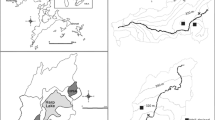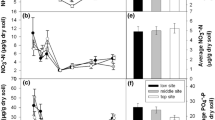Abstract
Urbanization substantially increases nitrogen (N) inputs and hydrologic losses relative to wildland ecosystems, although the fate of N additions to lawns and remnant grasslands remains contested. In montane semi-arid ecosystems, N cycling is often closely coupled to snowmelt (the dominant period of infiltration) and snow cover, which impact soil temperature and moisture. Here, we compared soil N dynamics between a fertilized and irrigated urban lawn and nearby riparian meadow in Salt Lake City, Utah during a snow manipulation experiment. Snow removal increased freeze/thaw events but did not affect N pools, microbial biomass, denitrification potential, or soil oxygen (O2). Mineral N was similar between sites despite lawn fertilization, but dissolved organic N (DON) was four-fold greater (2.1 ± 0.1 mg N l−1) in lawn soil water. Infiltration was lower in the lawn subsoil, and leaching losses (modeled with Hydrus) were small at both sites (< 2 kg N ha−1 y−1) despite substantial lawn fertilization. Lawn soil O2 fluctuated between 20.9 and 1.6 % following snowmelt and irrigation, but remained near 20 % in the meadow; the lawn had more reducing microsites as indicated by iron speciation. Post-snowmelt potential denitrification was six-fold greater in the lawn than the meadow. Lawns can potentially provide hotspots of denitrification in a semi-arid landscape that exceed some natural riparian ecosystems, whereas DON may represent an increasingly important form of N loss from lawns.





Similar content being viewed by others
References
Baker LA, Hope D, Xu Y, et al. (2001) Nitrogen balance for the central Arizona-Phoenix (CAP) ecosystem. Ecosystems 4:582–602. doi:10.1007/s10021-001-0031-2
Barton L, Colmer TD (2006) Irrigation and fertiliser strategies for minimising nitrogen leaching from turfgrass. Agric Water Manag 80:160–175. doi:10.1016/j.agwat.2005.07.011
Bernhardt ES, Band LE, Walsh CJ, Berke PE (2008) Understanding, managing, and minimizing urban impacts on surface water nitrogen loading. Ann N Y Acad Sci 1134:61–96. doi:10.1196/annals.1439.014
Brookes PC, Landman A, Pruden G, Jenkinson DS (1985) Chloroform fumigation and the release of soil nitrogen: A rapid direct extraction method to measure microbial biomass nitrogen in soil. Soil Biol Biochem 17:837–842. doi:10.1016/0038-0717(85)90144-0
Brooks PD, Campbell DH, Tonnessen KA, Heuer K (1999) Natural variability in N export from headwater catchments: snow cover controls on ecosystem N retention. Hydrol Process 13:2191–2201. doi:10.1002/(SICI)1099-1085(199910)13:14/15<2191::AID-HYP849>3.0.CO;2-L
Brooks PD, Grogan P, Templer PH, et al. (2011) Carbon and nitrogen cycling in snow-covered environments. Geogr Compass 5:682–699. doi:10.1111/j.1749-8198.2011.00420.x
Brooks PD, Schmidt SK, Williams MW (1997) Winter production of CO2 and N2O from alpine tundra: Environmental controls and relationship to inter-system C and N fluxes. Oecologia 110:403–413. doi:10.1007/PL00008814
Brooks PD, Williams MW (1999) Snowpack controls on nitrogen cycling and export in seasonally snow-covered catchments. Hydrol Process 13:2177–2190. doi:10.1002/(SICI)1099-1085(199910)13:14/15<2177::AID-HYP850>3.0.CO;2-V
Burgin AJ, Groffman PM, Lewis DN (2010) Factors regulating denitrification in a riparian wetland. Soil Sci Soc Am J 74:1826. doi:10.2136/sssaj2009.0463
Campbell JL, Socci AM, Templer PH (2014) Increased nitrogen leaching following soil freezing is due to decreased root uptake in a northern hardwood forest. Glob Chang Biol 20:2663–2673. doi:10.1111/gcb.12532
Covino TP, McGlynn BL (2007) Stream gains and losses across a mountain-to-valley transition: Impacts on watershed hydrology and stream water chemistry. Water Resour Res 43:W10431. doi:10.1029/2006WR005544
Dawson TE, Ehleringer JR (1991) Streamside trees that do not use stream water. Nature 350:335–337. doi:10.1038/350335a0
Durán J, Rodríguez A, Morse JL, Groffman PM (2013) Winter climate change effects on soil C and N cycles in urban grasslands. Glob Chang Biol 19:2826–2837. doi:10.1111/gcb.12238
Ehleringer JR, Arnow LA, Arnow T, et al. (1992) Red Butte Canyon Research Natural Area: history, flora, geology, climate, and ecology. Gt Basin Nat 52:95–121
Fenn ME, Haeuber R, Tonnesen GS, et al. (2003) Nitrogen emissions, deposition, and monitoring in the western United States. Bioscience 53:391–403. doi:10.1641/0006-3568(2003)053[0391:NEDAMI]2.0.CO;2
Fierer N, Schimel JP (2003) A proposed mechanism for the pulse in carbon dioxide production commonly observed following the rapid rewetting of a dry soil. Soil Sci Soc Am J 67:798–805. doi:10.2136/sssaj2003.7980
Fitzhugh RD, Driscoll CT, Groffman PM, et al. (2001) Effects of soil freezing disturbance on soil solution nitrogen, phosphorus, and carbon chemistry in a northern hardwood ecosystem. Biogeochemistry 56:215–238. doi:10.1023/A:1013076609950
Frank KW, O’Reilly KM, Crum JR, Calhoun RN (2006) The fate of nitrogen applied to a mature Kentucky bluegrass turf. Crop Sci 46:209. doi:10.2135/cropsci2005.04-0039
Groffman PM, Boulware NJ, Zipperer WC, et al. (2002) Soil nitrogen cycle processes in urban riparian zones. Environ Sci Technol 36:4547–4552. doi:10.1021/es020649z
Groffman PM, Driscoll CT, Fahey TJ, et al. (2001) Effects of mild winter freezing on soil nitrogen and carbon dynamics in a northern hardwood forest. Biogeochemistry 56:191–213. doi:10.1023/A:1013024603959
Groffman PM, Hardy JP, Fashu-Kanu S, et al. (2010) Snow depth, soil freezing and nitrogen cycling in a northern hardwood forest landscape. Biogeochemistry 102:223–238. doi:10.1007/s10533-010-9436-3
Groffman PM, Hardy JP, Fisk MC, et al. (2009a) Climate variation and soil carbon and nitrogen cycling processes in a northern hardwood forest. Ecosystems 12:927–943. doi:10.1007/s10021-009-9268-y
Groffman PM, Holland EA, Myrold DD, et al. (1999) Denitrification. In: Robertson GP, Bledsoe CS, Coleman DC, Sollins P (eds) Standard Soil Methods for Long-Term Ecological Research. Oxford University Press, New York, pp. 272–290
Groffman PM, Law NL, Belt KT, et al. (2004) Nitrogen fluxes and retention in urban watershed ecosystems. Ecosystems 7:393–403. doi:10.1007/s10021-003-0039-x
Groffman PM, Williams CO, Pouyat RV, et al. (2009b) Nitrate leaching and nitrous oxide flux in urban forests and grasslands. J Environ Qual 38:1848. doi:10.2134/jeq2008.0521
Hale RL, Turnbull L, Earl S, et al. (2014) Sources and transport of nitrogen in arid urban watersheds. Environ Sci Technol 48:6211–6219. doi:10.1021/es501039t
Hall SJ, McDowell WH, Silver WL (2013) When wet gets wetter: Decoupling of moisture, redox biogeochemistry, and greenhouse gas fluxes in a humid tropical forest soil. Ecosystems 16:576–589. doi:10.1007/s10021-012-9631-2
Hall SJ, Weintraub SR, Eiriksson D, et al. (2016) Stream nitrogen inputs reflect groundwater across a snowmelt-dominated montane to urban watershed. Environmental Science & Technology In press. doi:10.1021/acs.est.5b04805
Janke BD, Finlay JC, Hobbie SE, et al. (2014) Contrasting influences of stormflow and baseflow pathways on nitrogen and phosphorus export from an urban watershed. Biogeochemistry 121:209–228. doi:10.1007/s10533-013-9926-1
Kaushal SS, Groffman PM, Band LE, et al. (2011) Tracking nonpoint source nitrogen pollution in human-impacted watersheds. Environ Sci Technol 45:8225–8232. doi:10.1021/es200779e
Kaye JP, McCulley RL, Burke IC (2005) Carbon fluxes, nitrogen cycling, and soil microbial communities in adjacent urban, native and agricultural ecosystems. Glob Chang Biol 11:575–587. doi:10.1111/j.1365-2486.2005.00921.x
MacDonald GM (2010) Water, climate change, and sustainability in the southwest. Proc Natl Acad Sci 107:21256–21262. doi:10.1073/pnas.0909651107
McClain M, Boyer E, D CL, et al. (2003) Biogeochemical hot spots and hot moments at the interface of terrestrial and aquatic ecosystems. Ecosystems 6:301–312. doi:10.1007/s10021-003-0161-9
Morse JL, Durán J, Groffman PM (2015) Soil denitrification fluxes in a northern hardwood forest: the importance of snowmelt and implications for ecosystem N budgets. Ecosystems 18:520–532. doi:10.1007/s10021-015-9844-2
Moyes AB, Bowling DR (2013) Interannual variation in seasonal drivers of soil respiration in a semi-arid Rocky Mountain meadow. Biogeochemistry 113:683–697. doi:10.1007/s10533-012-9797-x
Neff JC, Chapin FS, Vitousek PM (2003) Breaks in the cycle: dissolved organic nitrogen in terrestrial ecosystems. Front Ecol Environ 1:205–211. doi:10.1890/1540-9295(2003)001[0205:BITCDO]2.0.CO;2
Pickett STA, Cadenasso ML, Grove JM, et al. (2011) Urban ecological systems: Scientific foundations and a decade of progress. J Environ Manag 92:331–362. doi:10.1016/j.jenvman.2010.08.022
Pinheiro J, Bates D, DebRoy S, et al (2014) nlme: linear and nonlinear mixed effects models.
Raciti SM, Burgin AJ, Groffman PM, et al. (2011b) Denitrification in suburban lawn soils. J Environ Qual 40:1932. doi:10.2134/jeq2011.0107
Raciti SM, Groffman PM, Fahey TJ (2008) Nitrogen retention in urban lawns and forests. Ecol Appl 18:1615–1626. doi:10.1890/07-1062.1
Raciti SM, Groffman PM, Jenkins JC, et al. (2011a) Accumulation of carbon and nitrogen in residential soils with different land-use histories. Ecosystems 14:287–297. doi:10.1007/s10021-010-9409-3
Raciti SM, Groffman PM, Jenkins JC, et al. (2011c) Nitrate production and availability in residential soils. Ecol Appl 21:2357–2366. doi:10.1890/10-2009.1
Roach WJ, Grimm NB (2011) Denitrification mitigates N flux through the stream–floodplain complex of a desert city. Ecol Appl 21:2618–2636. doi:10.1890/10-1613.1
Schaap MG, Leij FJ, van Genuchten MT (2001) Rosetta: a computer program for estimating soil hydraulic parameters with hierarchical pedotransfer functions. J Hydrol 251:163–176. doi:10.1016/S0022-1694(01)00466-8
Schaetzl RJ, Anderson S (2005) Soils: Genesis and Geomorphology. Cambridge University Press
Scherer-Lorenzen M, Palmborg C, Prinz A, Schulze E-D (2003) The role of plant diversity and composition for nitrate leaching in grasslands. Ecology 84:1539–1552. doi:10.1890/0012-9658(2003)084[1539:TROPDA]2.0.CO;2
Simunek J, Sejna M, Saito H, et al. (2013) The HYDRUS-1D software package for simulating the movement of water, heat, and multiple solutes in variably saturated media. University of California Riverside, Riverside, CA, USA, Department of Environmental Sciences
Six J, Conant RT, Paul EA, Paustian K (2002) Stabilization mechanisms of soil organic matter: Implications for C-saturation of soils. Plant Soil 241:155–176. doi:10.1023/A:1016125726789
Solomon DK, Cerling TE (1987) The annual carbon dioxide cycle in a montane soil: observations, modeling, and implications for weathering. Water Resour Res 23:2257–2265. doi:10.1029/WR023i012p02257
Wang W, Haver D, Pataki DE (2014) Nitrogen budgets of urban lawns under three different management regimes in southern California. Biogeochemistry 121:127–148. doi:10.1007/s10533-013-9942-1
Zak DR, Groffman PM, Pregitzer KS, et al. (1990) The vernal dam: plant-microbe competition for nitrogen in northern hardwood forests. Ecology 71:651–656. doi:10.2307/1940319
Zhu W-X, Hope D, Gries C, Grimm NB (2006) Soil characteristics and the accumulation of inorganic nitrogen in an arid urban ecosystem. Ecosystems 9:711–724. doi:10.1007/s10021-006-0078-1
Acknowledgments
We thank Sue Pope, Lorenzo Lopez, and Marty Huebner from the University of Utah landscape staff for supporting our work on campus. We gratefully acknowledge field and lab assistance from Jillian Turner, Simone Jackson, Kendalynn Morris, Dave Eiriksson, Suvankar Chakraborty, Harrison Quinn, and Caitlin Szymanski. This research was supported by NSF EPSCoR grant IIA 1208732 awarded to Utah State University as part of the State of Utah Research Infrastructure Improvement Award. Any opinions, findings, and conclusions or recommendations expressed are those of the author(s) and do not necessarily reflect the views of the National Science Foundation.
Author information
Authors and Affiliations
Corresponding author
Electronic supplementary material
Supplemental Fig. 1
(DOCX 487 kb)
Supplemental Fig. 2
(DOCX 574 kb)
Supplemental Fig. 3
(DOCX 360 kb)
Supplemental Fig. 4
(DOCX 546 kb)
Rights and permissions
About this article
Cite this article
Hall, S.J., Baker, M.A., Jones, S.B. et al. Contrasting soil nitrogen dynamics across a montane meadow and urban lawn in a semi-arid watershed. Urban Ecosyst 19, 1083–1101 (2016). https://doi.org/10.1007/s11252-016-0538-0
Published:
Issue Date:
DOI: https://doi.org/10.1007/s11252-016-0538-0




